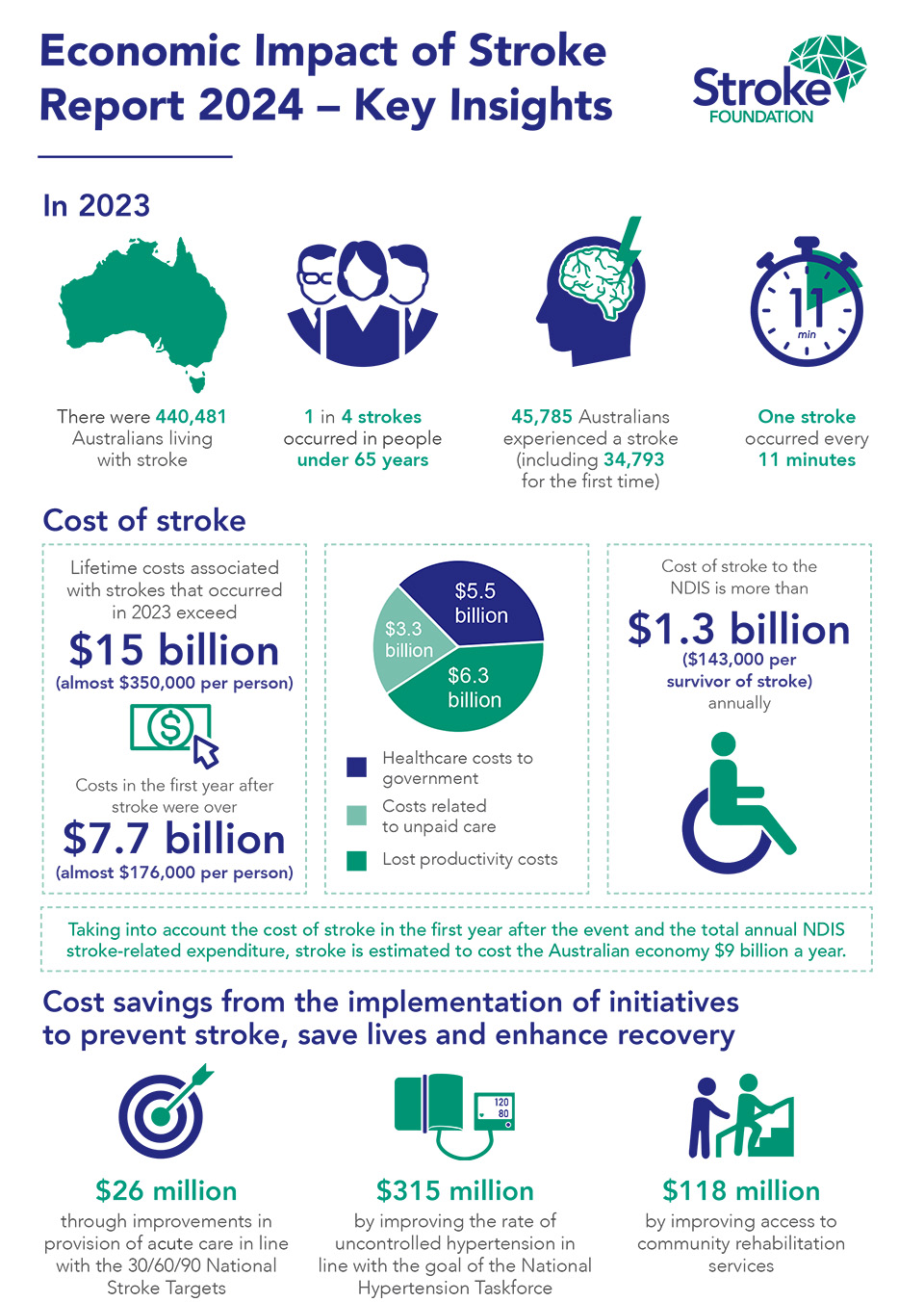Welcome to the home of the Economic Impact of Stroke Report where you will find key information and insights on stroke data and the economic impact of stroke to the Australian economy and community.
We acknowledge and thank our research partner, Monash University, and our sponsors Boehringer Ingelheim, the Angels Initiative and Medtronic. Most importantly we thank our incredible donors for helping make this report happen. Without your generous support, this report would not have been completed.
A brief message from Stroke Foundation’s CEO Dr Lisa Murphy
Why should I care about this report?
Stroke Foundation is proud to partner with Monash University to deliver the Economic Impact of Stroke 2024 Report which provides an evidence-base for why all of us, but particularly key decision-makers, industry, and governments, should care about stroke and do something about it (like making better policy and investments decisions).
The data coming out of this report will help us advocate for change, call for greater funding for and system improvements in stroke prevention, treatment, and enhanced recovery.
It’s a game-changing report for our community and will help Stroke Foundation call for urgent and important action to help survivors of stroke, their families and carers.
The numbers are clear: we need action to address stroke and its risk factors, without it the cost of stroke and the numbers of stroke are going to increase.
These aren’t just numbers: these are real people, real stories. We talk to people every day about the need for greater support and help navigating the system, and this report backs these conversations up.
The difference we can make by preventing stroke, improving treatment and supporting recovery efforts post stroke, drives us every day at Stroke Foundation. And this report helps us put numbers to the case for change, in addition to the voice of our community.
Releasing this report is the first step. The report will be a living document that will help drive our advocacy efforts and our strategic efforts to prevent stroke, save lives and enhance recovery. We hope it helps the stroke community with the evidence for change as well.
Ok, it’s important, but what does the 2024 report tell us?
The report tells us that the economic impact of stroke to the Australian economy every year is $9 billion.
There are 440,481 survivors living in the community.
45,785 Australians experienced a stroke in 2023. That’s one stroke every 11 minutes, and 34,793 strokes were experienced for the first time.
1 in 4 strokes occurred in people under 65 years.
In estimating the lifetime costs associated with strokes that occurred in 2023, the economic impact was $15 billion, almost $350,000 per person. That’s made up of $5.5 billion in health care costs, $3.3 billion in costs related to unpaid care and $6.3 billion in lost productivity costs.
In the first year of this, the cost was estimated to be $7.7 billion. And if you add to that, the annual cost of the National Disability Insurance Scheme (NDIS) for stroke-related expenses, that’s an annual cost of $9 billion.
That’s a lot of money. And a lot of lives impacted by stroke.
The good news is that we know we can do things now to reduce those costs and improve the lives of survivors of stroke.
The report estimated that if governments and hospitals delivered on the new 30/60/90 National Stroke Targets, not only would there be huge benefits to survivors of stroke in receiving better treatment, but the economic benefit would be $26 million.
If Australians improved their blood pressure and we were able to achieve the National Hypertension Taskforce goal of improving uncontrolled blood pressure from 32% (where it is now) to 70% (2030 goal), the economic benefit would be $315 million. And that’s being conservative.
Finally, we must improve the supports people receive post stroke, and community rehabilitation is lagging. If we made simple improvements now, the economic benefit would be $118 million.
When 1.9 million brain cells die every minute that a stroke is taking place, we have no time to waste.
Unless we treat stroke with the seriousness it deserves and the urgency needed, these numbers will continue to rise.
We can do something about it, what are we waiting for?

You’ve got me interested. I want to read the report, how do I download a copy?
To read more about the Economic Impact of Stroke 2024 Report, you can download the following resources:
How does this impact me?
If you want to know more about how stroke and its risk factors impacts you and your community, we have developed a series of state and territory snapshots:
We have also built a website where you can search your postcode. Previously we commissioned a report called ‘No Postcode Untouched’ but have not released an update to the report this year. Instead, we have an interactive page for people to visit!
Stroke Impact: How stroke is affecting your community
I’m feeling motivated, can I share with my friends and community?
Yes, we would love the support of our community to share this report far-and-wide and join our advocacy efforts!
Here are some ways you can get involved:
What’s the history of this report?
Stroke Foundation has been around for more than 25 years, and we have been leading the way in driving national conversations on stroke. This includes investing in research and releasing major reports.
So, it is no surprise that this isn’t the first report we have released.
This is the third update of the Economic Impact of Stroke Report commissioned by Stroke Foundation, with previous reports published in 2013 and 2020.
We also commissioned reports looking at postcode data and stroke hotspots, called No Postcode Untouched.
If you’re interested in checking out past reports, you can download them here:
2020 Economic Impact of Stroke Report
2020 No Postcode Untouched Report
2017 No Postcode Untouched Report

